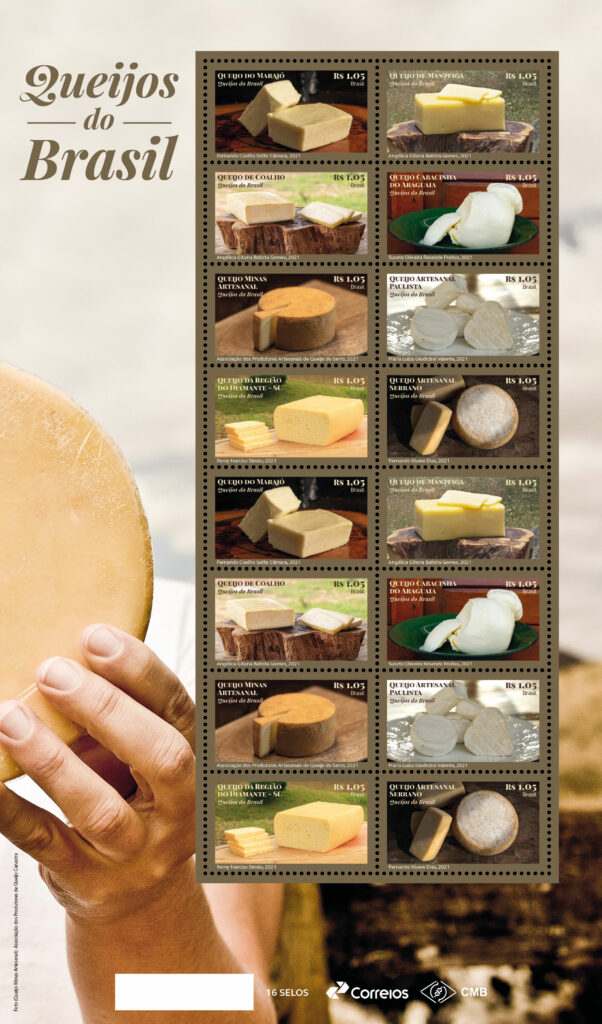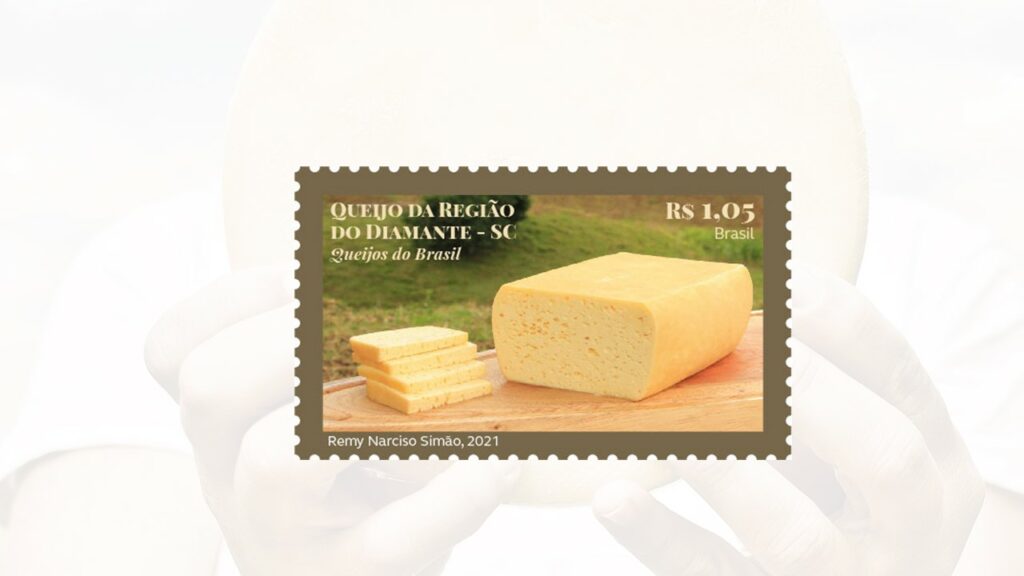Confira abaixo, na íntegra, a tradução do texto do Edital da emissão especial Queijos do Brasil
Brazilian cheeses
See below the full translation of the offical text for the stamp issue “Brazilian Cheeses“

The production of artisanal cheese is the result of knowledge that dates back to colonial Brazil and has been passed down from generation to generation. With the decline of the main Brazilian economic cycles, cheese was gaining ground and consolidating.
The artisanal cheese is highly appreciated by consumers in Brazil. Several of these consumers are interested in the origin and form of production of the food products they consume, as well as their reputation, intrinsic value and identity. The Geographical Indication, for providing control mechanisms and product traceability and for promoting sustainable practices that preserve biodiversity, fits into this trend and adds value to the products, highlighting the typicality of each territory.
As Brazilian artisanal cheeses are spread throughout the country, here we bring the five Brazilian regions represented by some of these cheeses.
Marajó Cheese

Marajó Cheese has over 200 years of history. It was introduced to the region with the arrival of Portuguese and French settlers. Initially it was produced only with cow’s milk by the families of European descendants, being widely consumed throughout the island. With the arrival of buffaloes in the region, there was an expansion and currently, Marajó Cheese is produced from milk, originating mainly from buffalo cattle or by a composition of buffalo and bovine milk.
Marajó Cheese can only be made under the characteristic climatic conditions and handling of the region’s herd. There are two types of Marajó Cheese, the butter type and the cream type. Cream cheese is characterized by the process of cooking the dough, called “frying”, in which the cream obtained from skimming the milk to be coagulated is added. With the techniques brought by the Europeans, the production process of cream cheese underwent changes and adaptations, mainly with the use of the creamer. Butter type cheese is the one that in the process of cooking the dough, the butter itself is added.
The relevance of the Geographical Indication for the Marajó Cheese product is immense, as it is a differential that values and protects the way of making, tradition, culture, identity and adds value to traditional products, opening markets, promoting the economic development of island, improving the lives of milk and cheese producers in Marajó, in addition to encouraging investments in the production area itself.
Cabacinha do Araguaia cheese

The fame of the Queijo Cabacinha do Araguaia is due to its know-how, which is passed on from generation to generation. The famous cheese is produced with the same quality and form of production in 10 municipalities, five in the state of Mato Grosso and five in Goiás. The Cabacinha cheese was declared cultural heritage in both states.
The dough is prepared with several waters, until obtaining a smooth and shiny dough. The specificity is in the acidity of the dough and in the shape of the product. Inside, the cabacinha cheese has layers like an onion. The method of preparation is different from cabacinha cheeses from other regions. It has the most characteristic milk flavor. When fried, the cheese is crunchy on the outside and creamy on the inside. The cheese is sold frozen and ripened. Due to the traditional know-how of making, it is made by hand in the gourd shape and this gives it a different texture from other known cheeses.
Artisanal Minas Cheese

The Minas Artesanal Cheese has its origins in the 18th century, a culture brought by the Portuguese who entered the territory of Minas Gerais in search of gold and diamonds. Cheese production took place around this mined territory, for the subsistence of families living there and also for supplying other regions of the province as well as a capital, Rio de Janeiro.
Since then, the production of Queijo Minas Artesanal has spread throughout the territory of Minas Gerais, representing a cultural factor of socio-economic importance for most rural families. This cheese production, even with the advent of technology, does not cease because it is an activity that has a history, it belongs to the “modus vivendi” of local families who, since the beginning of the occupation of these fields, saw in the manufacture of cheese as a safe alternative to income and disclosure. It is estimated that around ten thousand families are currently engaged in the production of this cheese in the state.
The government of Minas Gerais officially recognizes eight producing regions of Minas Artesanal Cheese: Araxá, Campo das Vertentes, Canastra, Cerrado, Serra do Salitre, Serra do Ibitipoca, Serro and Triângulo.
Coalho Cheese and Butter Cheese


The Northeastern hinterland was born cattle-raising, erecting its corrals and producing food for subsistence and to generate local economy, assuming its own regional characteristics, including the form and food recipes, such as the Coalho and Butter cheeses.
Historical accounts of where they were created, who made them and when were not highlighted. What is certain is that there are descriptions by travelers of the existence of country cheeses at the end of the 17th century, even if in an imprecise way and with some contradictions, since foreigners interpreted local foods in their own way.
The countryman Pery Lamartine reported that Coalho Cheese was the cheese for consumption in the house and sold at the local market, while Butter Cheese was for “preservation”, produced to keep for long periods of drought and also to trade over long distances. On most farms, the two were, and are still acquired together, and their stories are merged with these lands that resist to be cattle raising, valuing their food culture.
Serrano Craft Cheese

The production of Serrano Cheese occurs solely and exclusively in the Campos de Cima regions of the Serra de Santa Catarina and in Rio Grande do Sul, being one of the typical products of these regions which, although they belong to two states, present characteristics similar in terms of environment, culture and history.
The beginning of its manufacture dates back to the beginnings of the occupation of this territory by Portuguese descendants and, since then, it has been produced on rural properties by thousands of producers who transmit their way of doing it from generation to generation. Its manufacture is influenced by the environment, cattle feed and the handler’s handicraft work, being considered an identity food for the region’s inhabitants.
It is an artisanal product manufactured on a small scale, identified by a set of peculiar characteristics, related to flavor, aroma and texture, made with raw and whole bovine milk, mostly from beef cows that feed on native pastures.
In addition to its economic importance, many families produce cheese for cultural reasons, as they learned from their ancestors and producing it is a daily necessity. First Cheese with Geographical Indication in the Denomination of Origin modality in Brazil.
Diamond Region Cheese

Diamond cheese is a traditional colonial cheese, produced by approximately 25 families in small rural communities in the municipality of Major Gercino, Santa Catarina, the main one being the community of Diamante. Part of the cheesemaking tradition of this town is due to the strong traces of European immigration, especially from Germans, Italians and Poles.
It is a cheese produced with raw milk, at an average altitude of 700 meters, giving it special characteristics, influenced by temperature, humidity and its native pastures. It has a rectangular shape, due to the use of pink cedar wood shapes in different sizes. Once ready, it can be cured for a period of 15 to 40 days. These characteristics give this cheese a lot of personality and identity with a smooth flavor and a smooth texture. The peel is yellow, resulting from the daily washing of the pieces.
São Paulo Artisanal Cheese

In recent years, the cheese culture has been growing and spreading in the state of São Paulo. A real revolution. Consumers in the city of São Paulo, increasingly demanding and selective, found in the state’s producers an alternative to meet their demand.
In view of this, São Paulo producers went in search of teachings, techniques, and manufacturing processes – some sought knowledge abroad, others developed their own manufacturing method, others rescued sometimes forgotten traditions rooted in the family.
In this mix of techniques, the São Paulo Artisanal Cheese emerges – a synergy between producers from different regions of the state, each one with its characteristics, history, herd, but always with the same purpose – to bring to the consumer products made with technique, quality and lots of flavor.
The São Paulo Craft Cheese is in itself a great attraction, it is challenging and unique. Each producer puts in their cheese their DNA, their history, the daily dedication of the man and woman of the countryside.
São Paulo artisan cheese is innovative.
There are currently more than 300 varieties of cheese produced in the state of São Paulo, in artisanal cheese factories located in several municipalities, generating income and strengthening rural tourism in the state.
Sebrae and entities representing cheese producing regions